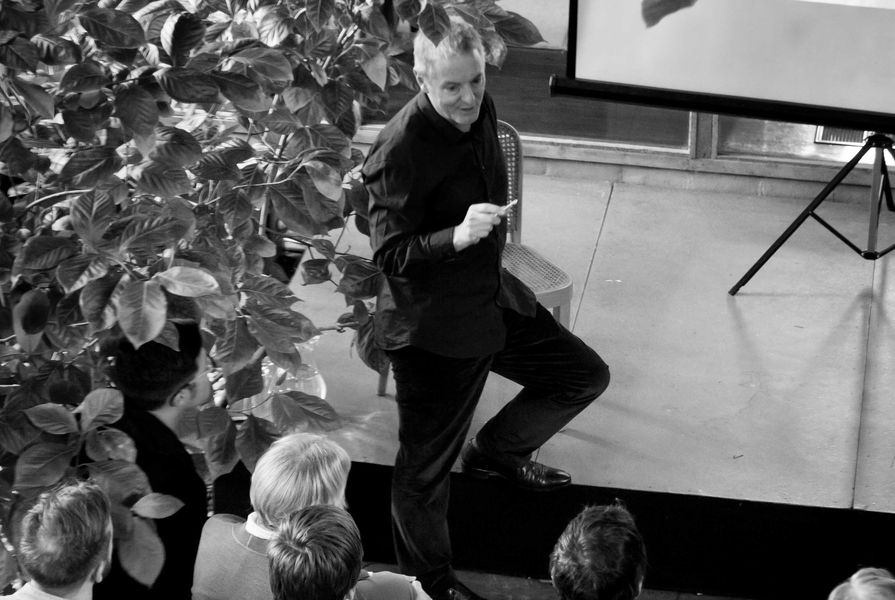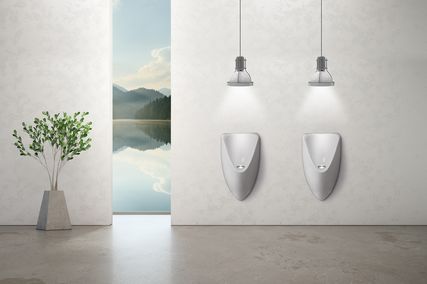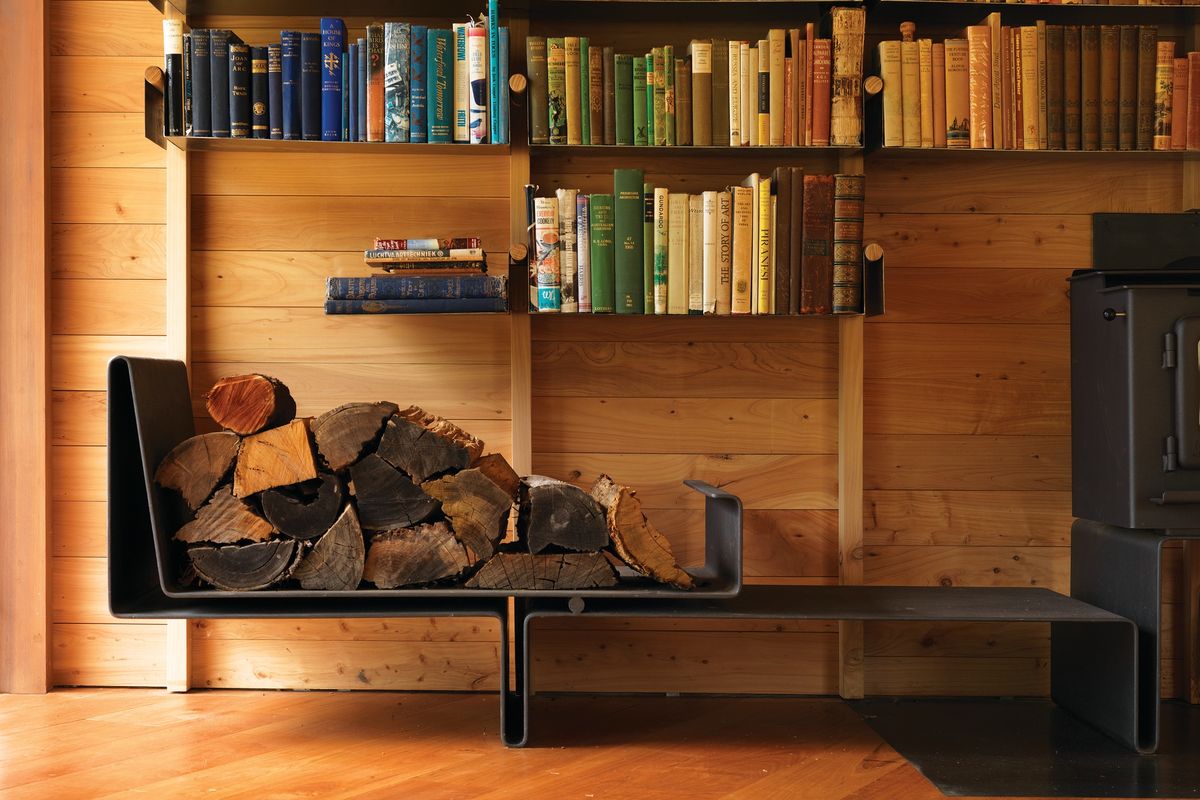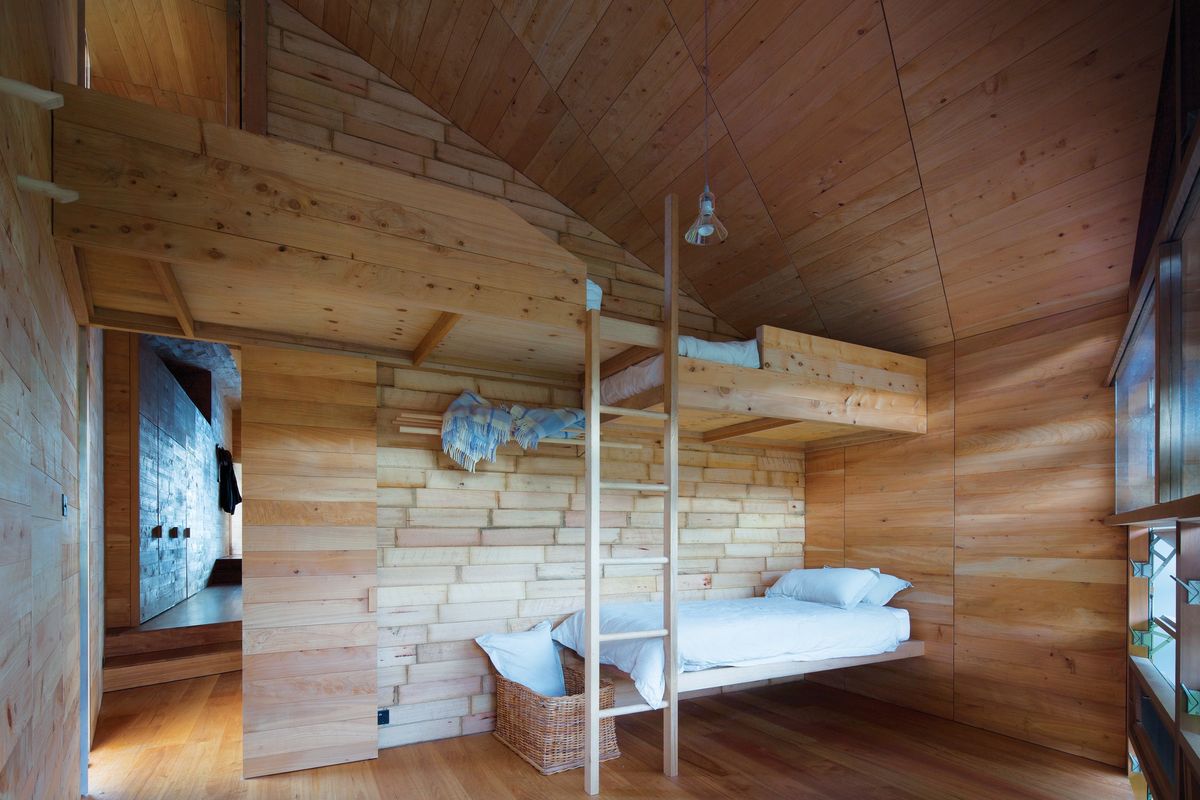“If I can tell you one thing about this little building, it is certainly the product of a distracted mind … but it’s also been a great antidote to the practice of architecture.”

Houses editor Katelin Butler with architect John Wardle at the Walsh Street House by Robin Boyd.
Image: Jonathan Butler
John Wardle addressed his peers and devotees of architecture in early December 2012 as part of the Our Houses conversation series by Houses magazine. The “little building” he spoke about is the Shearer’s Quarters on Bruny Island, Tasmania, which won the Australian Institute of Architects 2012 Robin Boyd Award for Residential Architecture, the 2012 Australian House of the Year at the Houses Awards and the Villa category at the 2012 World Architecture Festival. It’s a jewel clinging to coastal bluff: a blend of rustic charm and city sensibility, designed to replace a shearing shed destroyed by fire in the 1980s on Wardle’s family property.
There could have been no better place to hear this story than the Walsh Street House in South Yarra, Melbourne, which Robin Boyd built for his family. With its rough wood ceilings slung across the site on steel cables, it epitomizes the Australian inventive spirit, as does Wardle’s “little building.”
The focus of Wardle’s story was on the people and the place, and he sketched it out with anecdotes and wry wit, starting at the very beginning. It was Wardle’s parents who planted the seed of a rural life in him when they packed the family off to Britain when Wardle was a boy, and sold his toy farm set in the process. “I think that stayed with me and eventually drove me to reclaim my long lost farm,” he said.
Shearer’s Quarters is a working sheep station.
Image: Trevor Mein
Then, when a teacher of Wardle’s, “who would recite The Rime of the Ancient Mariner,” retired to Tasmania, it focused the architect’s search south, where he found acreage on the blustery northern tip of Bruny Island. The land had been granted to a sea captain who, in 1820, built a farmhouse precariously close to the sea’s edge. “Storm Bay can be tranquil but quite vicious in the massive coastal swells you get down there,” warned Wardle. “Farmers would have more sensibly built much closer to the road … but that’s what attracted our family to the site.”
The site has seen many occupations over the years: a whaling station, an apple and pear orchard and a sheep station. “Yes, it’s a real working sheep station, which means I’m involved in the parallel precarious enterprises of sheep and architecture, neither of which make money,” he observed, amusing both himself and the audience. “Having bought the place, it was many years before we drew up the new Shearer’s Quarters.”
“This is a project we squeezed in between other work the practice is fortunate to have on. But very early, we saw the potential to involve our staff beyond the building of Shearer’s Quarters, as a counterpoint to the highly urbanized space our practice inhabits.” People from Wardle’s practice have been regularly staying at the property, collecting seeds and planting trees – around seven thousand to date – regenerating the forest. “It’s a breeding ground for two of Tasmania’s rarest birds: the Swift Parrot and the Forty-spotted Pardalote. Of the 1,200 acres, we’ve locked up nearly a third as a sanctuary in perpetuity.”
A bedroom and bunks in Shearer’s Quarters, lined in reclaimed apple crate timbers.
Image: Trevor Mein
Wardle spoke of his search for salvage materials with which to build the Shearer’s Quarters. Farmers around the island and in the Huon Valley donated from their stockpiles of macrocarpus, “which we used for pretty much everything inside the building,” he enthused, explaining the common windbreak tree is nearing the end of its hundred-year life in many parts of Tasmania, “so farmers everywhere have more than they know what to do with.” He spoke of collecting convict-era bricks for the chimney from Hobart, and wood from apple crates found in sheds all over the Huon Valley, abandoned since the 1970s when Britain joined the common market, crushing the local apple industry overnight. Wardle used this wood to beautifully line the bedrooms and build bunk beds.
He told us about the sheltered workshop in Hobart that had milled the macrocarpus into lining boards, and about the carpenter who was “as dismayed as I was delighted” that the boards should already be lightly warping. “We knew they would, given it’s an unstable timber, not really suitable for joinery. But I like the imperfection,” said Wardle, as he talked about layers of meaning in materials and structure, their connection to local history.
He talked too about the local community, which helped build his son Luis’s shed from local stone and remnants of the Kettering pier, and of “hastily agreeing to provide honorary architectural services” to build a new general store, gallery and cafe at Denes Point.” Occasionally, he spoke of himself, offering a glimpse into the more private corners of that “distracted” and complex mind. “I’ve got many odd collections of things between technology and design, such as the Bole cameras from the 1960s that Stanley Kubrick used in his films.”
Detail of the steel firewood rack and bookshelves inside Shearer’s Quarters.
Image: Trevor Mein
At times, Wardle was the preeminent architect and practiced presenter on stage, talking of metalwork and chimney details and concealed ventilation hatches, or describing the twisting of the skillion roof up into a gable (an algorithm his practice now uses in other projects). But mostly we heard from Wardle the shepherd, a gatherer of family and helpers on a journey that is vastly more significant than the making of a building, or the winning of awards. A journey that has touched lives, taught much and galvanised communities.
“As architects, we can have a fairly narrow focus, unfortunately – bound up with the complexities of practice. We get too distracted by the current news. Of course, I have the luxury of a great office allowing me to stray off the path somewhat … but as a practice we insist on doing small projects when we can beause they help you keep that connection with layers of experience. I’m very interested in those social histories.”
Asked at the end of the talk if he was surprised by all the attention his “little building” has received this year, Wardle quickly shifted the focus from himself. “It’s a convenient moment in history, when architects are really looking at what we do and what’s important in a rapidly changing world in an increasingly fragile environment. Somehow this [building] does tug at the heart strings. There’s something about its sensory nature, the complexity of detail that gets more finely rendered as you get closer to it. It’s got that ambitious storytelling in something that’s quite small.”
Shearer’s Quarters was reviewed in Architecture Australia. The Our Houses talk was supported by the Robin Boyd Foundation.



























